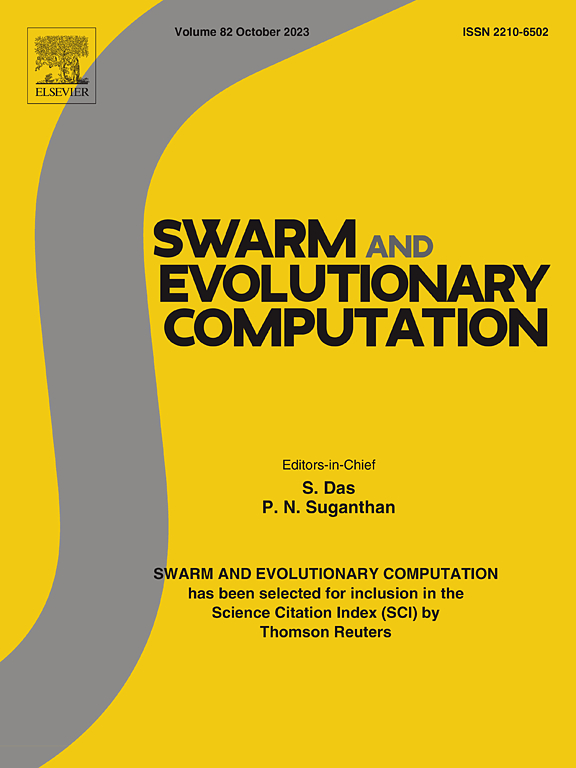A coevolutionary algorithm for constrained multi-objective optimization with dynamic relaxation
IF 8.2
1区 计算机科学
Q1 COMPUTER SCIENCE, ARTIFICIAL INTELLIGENCE
引用次数: 0
Abstract
To effectively address constrained multi-objective problems, algorithms need to strike a balance between objectives and constraints. This article introduces a method that utilizes two separate populations to investigate the exploration of the constrained Pareto front (CPF) and the unconstrained Pareto front (UPF). The fitness of each population is evaluated based on the information entropy of their positions, and suitable evolutionary operators are employed to improve solution quality in terms of convergence and diversity. Moreover, by adaptively relaxing constraint conditions, the auxiliary population can traverse large infeasible domains, thereby enhancing solution diversity. In the initial stages, the auxiliary population evolves alongside the main population, bringing it close to the CPF and minimizing computational resource wastage. A tournament environment selection model based on a dynamic relaxation (DR) function is utilized in the later stages, helping the auxiliary population relax constraints, retain promising solutions, and augment diversity. In addition, an entropy selection evolutionary strategy was designed to address the problem of populations easily falling into local optima during the evolution process. By calculating the entropy information of the population, the current state of the population can be determined, and then appropriate operators can be selected to enable the population to effectively escape from local optimal solutions. Compared against seven state-of-the-art algorithms, demonstrate that the proposed constrained multi-objective optimization evolutionary algorithm (CMOEA) surpasses the performance of existing CMOEAs.
动态松弛约束多目标优化的协同进化算法
为了有效地解决约束多目标问题,算法需要在目标和约束之间取得平衡。本文介绍了一种利用两个独立种群来研究有约束帕累托前沿(CPF)和无约束帕累托前沿(UPF)的探索方法。根据每个种群位置的信息熵来评估其适应度,并采用合适的进化算子来提高解的收敛性和多样性。此外,通过自适应放宽约束条件,辅助种群可以遍历较大的不可行域,从而提高了解的多样性。在初始阶段,辅助种群与主要种群一起进化,使其接近CPF并最大限度地减少计算资源浪费。在后期阶段,利用基于动态松弛(DR)函数的比赛环境选择模型,帮助辅助种群放松约束,保留有希望的解决方案,并增加多样性。此外,针对种群在进化过程中容易陷入局部最优的问题,设计了熵选择进化策略。通过计算种群的熵信息,确定种群的当前状态,选择合适的算子,使种群有效地脱离局部最优解。通过与7种最先进算法的比较,证明了所提出的约束多目标优化进化算法(CMOEA)的性能优于现有的约束多目标优化进化算法。
本文章由计算机程序翻译,如有差异,请以英文原文为准。
求助全文
约1分钟内获得全文
求助全文
来源期刊

Swarm and Evolutionary Computation
COMPUTER SCIENCE, ARTIFICIAL INTELLIGENCEC-COMPUTER SCIENCE, THEORY & METHODS
CiteScore
16.00
自引率
12.00%
发文量
169
期刊介绍:
Swarm and Evolutionary Computation is a pioneering peer-reviewed journal focused on the latest research and advancements in nature-inspired intelligent computation using swarm and evolutionary algorithms. It covers theoretical, experimental, and practical aspects of these paradigms and their hybrids, promoting interdisciplinary research. The journal prioritizes the publication of high-quality, original articles that push the boundaries of evolutionary computation and swarm intelligence. Additionally, it welcomes survey papers on current topics and novel applications. Topics of interest include but are not limited to: Genetic Algorithms, and Genetic Programming, Evolution Strategies, and Evolutionary Programming, Differential Evolution, Artificial Immune Systems, Particle Swarms, Ant Colony, Bacterial Foraging, Artificial Bees, Fireflies Algorithm, Harmony Search, Artificial Life, Digital Organisms, Estimation of Distribution Algorithms, Stochastic Diffusion Search, Quantum Computing, Nano Computing, Membrane Computing, Human-centric Computing, Hybridization of Algorithms, Memetic Computing, Autonomic Computing, Self-organizing systems, Combinatorial, Discrete, Binary, Constrained, Multi-objective, Multi-modal, Dynamic, and Large-scale Optimization.
 求助内容:
求助内容: 应助结果提醒方式:
应助结果提醒方式:


